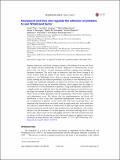| dc.contributor.author | Chen, Hsieh | |
| dc.contributor.author | Angerer, Jennifer I. | |
| dc.contributor.author | Napoleone, Marina | |
| dc.contributor.author | Reininger, Armin J. | |
| dc.contributor.author | Schneider, Stefan W. | |
| dc.contributor.author | Wixforth, Achim | |
| dc.contributor.author | Schneider, Matthias F. | |
| dc.contributor.author | Alexander-Katz, Alfredo | |
| dc.date.accessioned | 2016-03-18T14:23:31Z | |
| dc.date.available | 2016-03-18T14:23:31Z | |
| dc.date.issued | 2013-12 | |
| dc.date.submitted | 2013-08 | |
| dc.identifier.issn | 19321058 | |
| dc.identifier.uri | http://hdl.handle.net/1721.1/101737 | |
| dc.description.abstract | Primary hemostasis and blood clotting is known to be influenced by the red blood cell volume fraction (hematocrit) in blood. Depressed or elevated levels of red blood cells can lead to vascular perfusion problems ranging from bleeding to thrombus formation. The early stage of hemostasis and thus blood clotting in all vessel sections from the arterial to the venous system involves the adhesion of platelets to von Willebrand factor. Here we present experimental and theoretical results showing that the adhesion probability of platelets to von Willebrand factor is strongly and nonlinearly dependent on hematocrit and flow rate. Interestingly, the actual binding forces are not markedly different, which suggest that the origin of such behavior is in the distribution of platelets. Using hydrodynamic simulations of a simple model, we explicitly show that the higher the hematocrit and the flow rate, the larger the amount of platelets residing close to the wall. Our simulation results, which are in excellent agreement with the experimental observations, explain why such phenomena occur. We believe that the nonhomogeneous red blood cell distribution as well as the shear dependent hydrodynamic interaction is key for the accumulation of platelets on the vessel wall. The work we present here is an important step forward from our earlier work on single molecules and extends into the collective cellular behavior of whole blood. It sheds new light on the correlation between hematocrit and the initial steps in hemostasis and thrombosis, and outlines advances for the treatment of vascular diseases associated with high levels of red blood cells. These results are not only highly relevant for the field of hemostasis and the physics of blood clotting but are also of powerful impact in applied science most obviously in drug delivery and colloidal science. | en_US |
| dc.description.sponsorship | National Science Foundation (U.S.) (CAREER Award 1054671) | en_US |
| dc.language.iso | en_US | |
| dc.publisher | American Institute of Physics (AIP) | en_US |
| dc.relation.isversionof | http://dx.doi.org/10.1063/1.4833975 | en_US |
| dc.rights | Article is made available in accordance with the publisher's policy and may be subject to US copyright law. Please refer to the publisher's site for terms of use. | en_US |
| dc.source | PMC | en_US |
| dc.title | Hematocrit and flow rate regulate the adhesion of platelets to von Willebrand factor | en_US |
| dc.type | Article | en_US |
| dc.identifier.citation | Chen, Hsieh, Jennifer I. Angerer, Marina Napoleone, Armin J. Reininger, Stefan W. Schneider, Achim Wixforth, Matthias F. Schneider, and Alfredo Alexander-Katz. “Hematocrit and Flow Rate Regulate the Adhesion of Platelets to von Willebrand Factor.” Biomicrofluidics 7, no. 6 (2013): 064113. © 2013 AIP Publishing LLC | en_US |
| dc.contributor.department | Massachusetts Institute of Technology. Department of Materials Science and Engineering | en_US |
| dc.contributor.mitauthor | Chen, Hsieh | en_US |
| dc.contributor.mitauthor | Alexander-Katz, Alfredo | en_US |
| dc.relation.journal | Biomicrofluidics | en_US |
| dc.eprint.version | Final published version | en_US |
| dc.type.uri | http://purl.org/eprint/type/JournalArticle | en_US |
| eprint.status | http://purl.org/eprint/status/PeerReviewed | en_US |
| dspace.orderedauthors | Chen, Hsieh; Angerer, Jennifer I.; Napoleone, Marina; Reininger, Armin J.; Schneider, Stefan W.; Wixforth, Achim; Schneider, Matthias F.; Alexander-Katz, Alfredo | en_US |
| dc.identifier.orcid | https://orcid.org/0000-0001-5554-1283 | |
| mit.license | PUBLISHER_POLICY | en_US |
